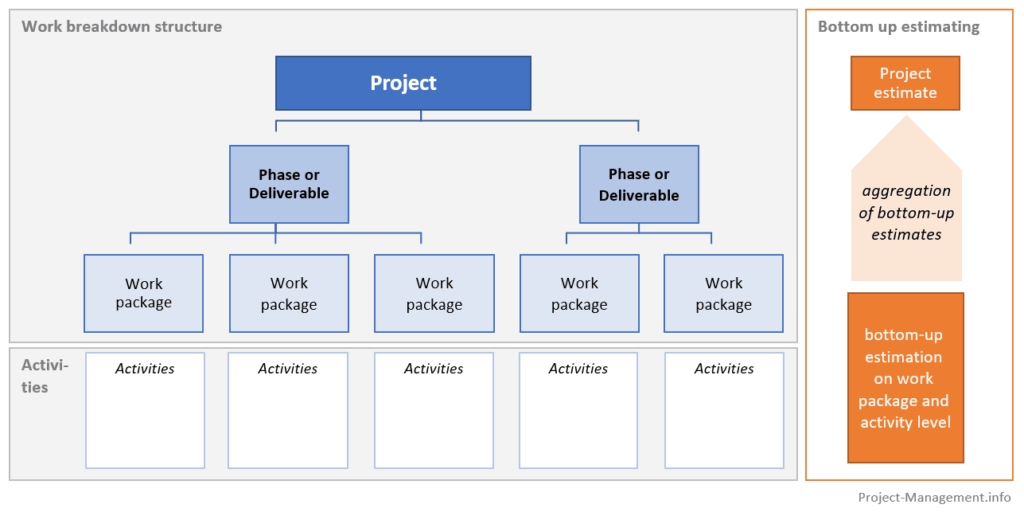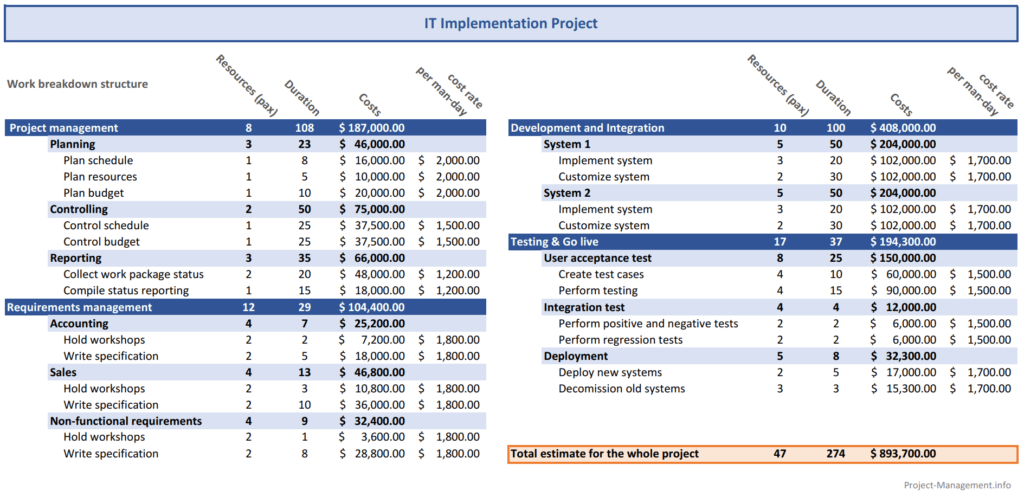Advantages Of Bottom Up Approach
Bottom-upwards estimating is a technique that involves estimations on a granular level for parts of a projection. These are then aggregated to a full estimate for the entire project. It is often referred to as 1 of the most authentic ways of estimating. Estimating cost, duration or resources requirements of a project typically starts with a rough order of magnitude in the kickoff. This is followed by more than accurate estimates later in a project.
In this article, we will innovate the concept, cover the differences and interdependencies with other interpretation techniques and provide guidance to and an example of bottom-upward estimating in projects.
What Is Lesser-Upward Estimating?
Bottom-up estimating is a technique in projection management for estimating the costs or duration of projects and parts of a project (PMBOK®, half dozenth edition, ch. 6.4.2.5, ch. 7.2.2.4). The term bottom-up estimating gives a hint nigh the underlying concept: costs, durations or resources requirements are estimated at a very granular level. This means that the estimation is done for work packages (some might suggest activities though) which are the everyman and well-nigh detailed level of a piece of work breakdown construction (WBS).

While the estimation is performed at the level of activities or piece of work packages, the estimate for the whole project is the sum of all granular estimates.
The bottom-up interpretation technique is also referred to as deterministic or detailed estimating (source: PMI Do Standard for Project Estimating, iind edition, ch. 4.ii.three). Information technology is often used every bit the then-called "definitive estimate" – a type of cost estimate that comes with an accurateness between -five% and +10% according to the Projection Management Constitute (PMI).
What Are the Differences between Bottom-Upwardly, Tiptop-Down and Parametric Estimating?
Analogous (meridian-downwards) and parametric estimating as well as practiced judgment can be applied at any level of granularity. In dissimilarity, the bottom-up estimation technique typically implies that it relates to the smallest component type in a project (e.g. piece of work packages and activities).
Nevertheless, teams tin also make use of those techniques when doing bottom-up estimating. The duration of an action, for instance, could be determined through analogous estimating by using the duration of similar historical activities. The resource needs could be adamant through parametric estimating, based on observed parameters such every bit construction cloth per foursquare human foot or lines of code per developer and hour. Expert judgment can also be used where sensible.
Read our detailed articles to learn more about analogous and parametric estimating.
How to Practise Bottom-Up Estimating?
The following pedagogy relates to estimations for the virtually granular component level of a project (e.thousand. a work package or an activity). In projects that apply PMI methodology, these components have been identified in the processes "create WBS" (PMBOK, ch. 5.4) and "define activities" (PMBOK®, ch. 6.two).
The results of these granular estimations are then rolled up to summate the estimate for the whole project.
There are iii types of bottom-up estimates:
- Estimating the resources needs
(PMBOK process "guess activity resources", ch. nine.2), - Estimating the time needed (duration)
(PMBOK process "estimate action duration", ch. six.four), - Estimating the costs
(PMBOK procedure "gauge costs", ch. 7.2).
There are some interdependencies betwixt these estimations: The duration of an action typically depends on the resources assigned to the activity. The toll estimates are then calculated by multiplying the resource units with the time and the price per unit of measurement.
Example of Lesser-Up Estimating
This department discusses a practical example of the application of the bottom-upward interpretation technique. The case is based on the following work breakup structure:

The work package owners are asked to approximate the resource needs (headcount), the duration and the total costs for each activeness nether their work package.
The following figure shows the granular estimates for the activities, their assemblage to the work parcel level and the entire project.

The requirements direction team, for instance, might have used analogous estimating. In that case, they estimated their resource, fourth dimension and upkeep needs based on observed values from previous workshops and specifications. Thus, they came upwardly with estimates of 12 persons, 29 days and $104,400 for their workstream.
The testing team, on the other hand, might know how many test cases a person ordinarily creates per twenty-four hours and how many cases a squad fellow member normally completes per day. They multiply these parameters with the number of expected exam cases in the current project, i. e. they are applying the parametric estimating technique.
The low-cal-blue rows in the above table show the estimates on the piece of work package level (i.eastward. the sum of the estimates of the activities). The dark-blue lines represent the second level of assemblage – the sum of resources, costs and duration on a phase level (equivalent level to that of deliverables in other WBS types).
The orange cells incorporate the total aggregates for the whole project: a total headcount of 47, a sum of fourth dimension needed of 274 days (which is not necessarily the projection duration, see explanation below) and total cost of $893,700.
Note that the numbers of headcount and time are only the sums of the corresponding granular estimates. In reality, the headcount might be lower as some team members could work in different activities and work packages. For instance, a business organisation analyst who writes specifications could too be deployed for testing in a later project phase.
The sum of the duration estimates of all activities does not necessarily equal the full duration of the projection. This is considering scheduling may lead to parallel activities or waiting time that is non estimated on the activity level. This is really a part of the development of the overall schedule.
Advantages and Disadvantages of Lesser-Upwards Estimating
Pros
- Bottom-upward estimates can be very accurate. This is because team members are estimating the slice of work they are responsible for. As they typically have the nigh knowledge of their piece of work bundle, their estimates tend to be much more than accurate than top-down estimates.
- Estimation errors tin balance out across the components of a projection. If the time or cost of 1 work packet has been underestimated, for example, this could be kickoff by an overestimation of some other work bundle. Such errors might therefore not necessarily impact the budget baseline at the projection level.
- Bottom-up estimating can be used in conjunction with other interpretation techniques, e.g. the activity duration could be obtained through parametric or analogous estimating.
Cons
- The underlying supposition is that the project estimate consists of the sum of its pieces. This may ignore overhead and integration efforts that may occur in add-on to the work divers in activities. This holds for large and complex projects, in detail.
- The bottom-up estimation itself requires a lot more than resources than other techniques such every bit analogous estimating (meridian-down estimation).
- The cost interpretation is based on the duration estimate. Both rely on the estimated resource requirements. Thus, an interpretation error there would lead to inaccurate time and cost estimates as well.
- In practice, bottom-upward estimates tin exist prone to the bias or the interests of the estimators. While this applies to all types of estimates (to some extent), it may be less manageable in bottom-up estimating. This is because these estimations are usually done by many different estimators, i.e. those responsible for a piece of work bundle.
Conclusion
Bottom-up estimating tin be a very accurate method to determine the definitive guess of a project. It requires a certain amount of resources and an established work breakdown structure. The projection must accept been cleaved downwardly to the work packet and activities level earlier y'all can utilize this technique.
Apart from estimating resources, fourth dimension and costs for the planned work of a project, this technique can besides exist used to assess change requests, east.g. in the class of a cost-do good analysis of such changes.
In that location are also several other techniques to gauge the costs or duration of projects and their components. Brand sure you read our commodity on cost estimating and estimating activity durations to get an overview and comparison of the different approaches.
Advantages Of Bottom Up Approach,
Source: https://project-management.info/bottom-up-estimating-definition-example-pros-cons/
Posted by: rosenbergequed1960.blogspot.com


0 Response to "Advantages Of Bottom Up Approach"
Post a Comment